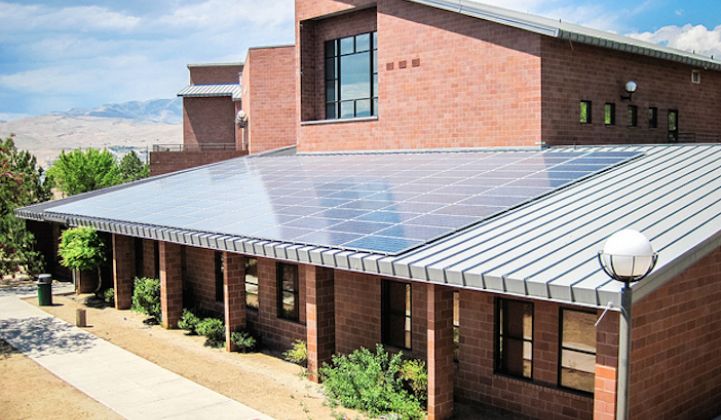According to national solar companies, Nevada’s rooftop solar industry is on the brink of collapse -- again.
A conflict over Nevada’s solar policy seemed to have been temporarily resolved this spring, after Governor Brian Sandoval helped broker an agreement to increase the amount of solar that qualifies for net metering through the end of the year.
In May, lawmakers passed an amendment to Senate Bill 374 allowing for 235 megawatts of net-metered solar through 2015. The law did not increase the state’s net metering cap (currently set at 3 percent of NV Energy’s peak load), but was expected to give solar companies market certainty until the public utilities commission could devise a longer-term solution.
The resolution didn’t last long, however. Last month, solar installers complained that the 235-megawatt limit would be hit by the end of this month. The Alliance for Solar Choice (TASC) filed a petition with the Public Service Commission to confirm that the net-metering program would continue until stakeholders established a new solar policy in the new year.
Then on Friday, NV Energy filed a 500-page application with the PUC proposing new rules and rates for net metered customers, requesting the changes be implemented by September 15.
The plan would establish a standard net-metering rate and an optional time-of-use net-metering rate. Both rates would have a three-part structure made up of a monthly basic service charge, a demand charge and an energy charge.
According to NV Energy, the basic service charge is a fixed fee that reflects the costs associated with back-office systems, software, meters, employees and services provided to net-metering customers. The demand charge reflects the bidirectional use of the grid and the investment NV Energy has to make in transmission, distribution and generating units to provide reliable service to its customers. The energy charge reflects the volume of energy used by the customer and varies based on consumption.
According to TASC’s calculations, the proposed rates would amount to a $40 monthly fee on most solar customers, who usually save $11-$15 per month on their electricity bills. As a result, TASC says the NV Energy proposal would kill the solar industry in the state and put 6,000 jobs at risk.
"NV Energy’s proposal would mean the certain end of Nevada’s rooftop solar industry, which is number one in the nation in solar jobs per capita,” said Will Craven, spokesperson for The Alliance for Solar Choice. “It would be tragic if Governor Sandoval’s Public Utilities Commission allows Nevada to go from number one in solar job creation, to number one in solar job elimination.”
NV Energy maintains that savings are still possible, even with the higher rates.
“To be clear, those who choose to install renewable distributed generation (DG) can reduce their Nevada Power bill under the NEM2 rules and rates, even though a customer who installs renewable DG might end up paying more for energy when the cost of buying or leasing the DG system, or purchasing the output of the DG system is taken into consideration,” states volume 2 of the filing.
Like many utilities, NV Energy claims the changes are needed to accurately reflect the costs of service solar customers. Senate Bill 374 gave the utility approval to implement fees on solar customers to avoid “unreasonable” cost-shifting to other utility customers.
"Consistent with the intent of Senate Bill 374, our proposal will create a smooth transition to the new net metering rules being established by the PUCN without interrupting the work being done by our state’s strong solar industry," said Paul Caudill, NV Energy president and CEO, in a statement.
"Despite what has been widely reported, NV Energy has no desire to impact jobs at a time when the state's economy needs them,” he continued. “We simply want to establish an environment that is sustainable, and with the low cost of large-scale solar energy available in the market today, the current net-metering subsidy is not.”
If approved, the new rules would kick in on September 15, and would not affect customers who installed solar under the current net-metering program. If the PUC decides to raise the net-metering cap in the new year, NV Energy customers that installed solar in the interim would receive a refund.
TASC is calling for regulators to reject the NV Energy proposal until it has been thoroughly vetted by the public, and instead approve the rooftop solar industry's petition to continue the existing net-metering program through the end of the year.
The PUC is expected to rule on NV Energy’s application this month. Under SB 374, regulators are required to develop a new solar tariff policy by December 31, 2015.



